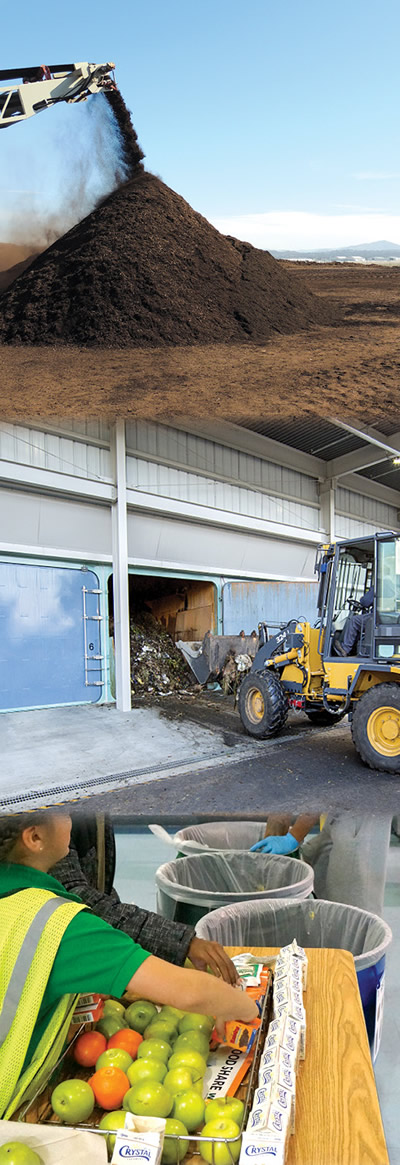The Director and Chief Deputy Director of CalRecycle explain scope of state’s landmark new climate law and describe creative solutions that are key to its success.
Scott Smithline and Ken DaRosa
BioCycle March/April 2018

Top: Compost screening at Miramar Greenery, San Diego
Middle: South San Francisco Scavenger anaerobic digestion facility, South San Francisco
Bottom: Food share table, Alameda County
Photos by Doug Pinkerton, Sabrina Bortoli, SSFSC and Nancy Deming
Fortunately, that revolution is underway.

Left: Scott Smithline, Director, CalRecycle
Right: BioCycle WEST COAST18 Keynote Speaker Ken DaRosa, Chief Deputy Director, CalRecycle
With that in mind, Governor Edmund G. Brown signed legislation in 2016 (Senate Bill 1383, Lara, Chapter 395, Statutes of 2016) that targets reduction of short-lived climate pollutants, including methane. The law directs the state’s Department of Resources Recycling & Recovery (CalRecycle) to adopt regulations and requirements to achieve a 50 percent reduction in organic waste disposal by 2020 and a 75 percent reduction by 2025. The law further requires that 20 percent of the amount of edible food currently disposed be recovered for human consumption by 2025. By calling for a significant reduction in current levels of organics disposal, this law signals a definitive shift in California’s approach to organic waste management:
• The 20 percent edible food recovery target requires that California achieve a measure of source reduction — prevention of waste in the first place and California’s highest waste management objective — in the program.
• Disposal reduction targets are linked to methane emission reductions.
• Target reductions are based on fixed disposal amounts tied to 2014 baselines regardless of any future economic or population growth.
Over the past year, CalRecycle has engaged with cities, counties, waste haulers, environmental groups, and other stakeholders through targeted meetings and public workshops to collectively redefine and innovate how we manage the state’s organic waste stream.
Right now, California recycles roughly 10 million tons of organic waste annually through composting, chip and grind, biomass energy, and more recently through anaerobic digestion (AD) facilities. The state’s existing organics recycling infrastructure consists of 15 AD facilities, approximately 20 biomass conversion facilities, 162 chip-and-grind operations, and 179 composting facilities (50 of the 179 handle nearly all of the green waste and food waste sent to composting). At full capacity, these facilities could process perhaps an additional one million tons/year of organics.
To achieve the targets outlined in SB 1383, California must recycle at least 20 million tons of organic waste. Depending on facility size, CalRecycle estimates the state will need 50 to 100 new or expanded composting and AD facilities — at roughly $2 billion in capital costs.
SB 1383 SCOPE
Regulatory Approach
Under SB 1383, CalRecycle has the opportunity to implement common sense, measureable requirements that enable California to track its greenhouse gas (GHG) reduction progress. These standards will also allow businesses and local governments to quantify the economic, environmental, and public health benefits for their customers and constituents.
A few of the regulatory concepts under discussion with stakeholders include:
• Jurisdictional authority to impose requirements on organic waste generators
• Authorization for CalRecycle or jurisdictions to impose penalties for noncompliance
• Organic waste collection requirements for residential and commercial generators
• Inspection and contamination reporting requirements for haulers and facilities
• Procurement requirements for recycled organic products
• Food recovery planning requirements
• Formal arrangements between generators of edible food and food recovery organizations
CalRecycle’s regulatory approach to SB 1383 includes providing clarity to California’s local governments, businesses, haulers, waste generators, and solid waste facilities on how California ultimately defines organic waste, disposal, and recycling. While readily compostable or digestible organic waste comprises roughly a third of California’s waste stream, that share balloons to roughly two-thirds when other organics such as lumber, paper, and natural carpet fibers and textiles are included.
After the release of draft regulatory language in October 2017, we began working to incorporate public comments and integrate stakeholder feedback. CalRecycle expects to release a second draft of regulatory language at public workshops in April 2018 and adopt final regulations in early 2019. This allows regulated entities to plan programmatic and budgetary changes necessary to be in compliance when the regulations take effect in 2022.
Community Support, Local Siting, And Permitting
Local land use decisions, air district requirements, water board regulations, and other permitting requirements serve important purposes and provide important protections. In recognizing this, we acknowledge the importance of, and need for, interagency coordination with our state and local partners.
While smart regulations will be instrumental to achieving California’s organic waste and methane emissions reduction targets, the success of SB 1383 hinges on support from local communities. There’s no question these organics recycling infrastructure projects help diversify our local economies and create durable green jobs that can’t be outsourced.
At the same time, communities have legitimate concerns about having such facilities as neighbors, among them increased traffic and road wear and potential odor issues. To that end, SB 1383 regulations must require that cities, counties, project proponents, and local enforcement agencies conduct community outreach when new projects are proposed, particularly in disadvantaged communities, to hear local concerns and discuss mitigation of potentially negative effects. CalRecycle will continue to provide local leaders and businesses with the tools needed to generate greater understanding and support for these recycling facilities through continued studies, technical research, and the distribution of best practices to encourage increased use of recycled organic products.
Sustainable Infrastructure Funding
The roughly $2 billion capital infrastructure investment required to meet SB 1383 goals is significant, but California is uniquely positioned to meet this challenge. Our businesses innovate, our industries adapt, and our local communities find solutions. We saw this after the passage of AB 939, the California Integrated Waste Management Act (Sher, Chapter 1095, Statutes of 1989), which established California’s jurisdictional 50 percent landfill diversion mandate and required a massive infrastructure expansion. AB 939 spurred investment and innovation to put new facilities in place and dramatically alter the state’s recycling landscape.
Since 2014, Cap-and-Trade funds have enabled CalRecycle to make more than $104 million in California Climate Investments to create or expand the state’s composting, AD, and food waste prevention and recovery capacity (Table 1). This funding provides an important jump-start for the infrastructure boost California needs, but it must also be leveraged by additional private investment to achieve the state’s methane and organic waste reduction targets under SB 1383.
According to a 2013 CalRecycle jobs report, increased recycling of California-generated organic waste has the potential to add more than 14,000 new jobs in the state. “For each new job created, at least one additional job would also be created or induced indirectly,” notes the report. Secondary jobs would often include new drivers for collection routes, manufacturing of specialized equipment or vehicles, or service workers to provide equipment maintenance or personal services for employees.
Market Development
Once the benefits of recycled organics like biofuel and compost are fully appreciated, demand for these products has the potential to exceed current supply. In addition to building soil carbon content and reducing California’s carbon emissions, increased compost use can reduce water usage for individuals, communities, and businesses, help build healthy soils, and increase the state’s agricultural productivity — all essential to climate resilience.
Right now, California generates about 26.6 million tons of organics each year. Of that, California composters process nearly 6 million tons to produce around 3.5 million tons of finished compost. If California composted nearly all of the readily compostable organic material it generates, we would produce enough compost to cover 2.5 million acres of California’s vast agricultural land. Doing so would increase its water holding capacity, reduce runoff, improve soil health and suitability for planting, all while increasing carbon sequestration.
To the extent possible, CalRecycle’s regulatory efforts for SB 1383 can help bolster markets for compost and other recycled organic products through procurement requirements as well as contamination and product testing standards. The department must also continue to promote nonregulatory initiatives to improve markets through funding and interagency programmatic efforts, including:
Low Carbon Fuel Standard: This is a California Air Resources Board-managed requirement for fuel sellers to account for the carbon content of their fuel. Biofuel from AD is the lowest carbon fuel available in California.
Healthy Soils Initiative. CalRecycle fully supports the California Department of Food and Agriculture incentive program for use of compost in the agricultural industry.
Food Waste Prevention And Food Rescue
Food waste alone accounts for roughly 18 percent of total landfill disposal (5 to 6 million tons) annually in California. To ensure that 20 percent of currently disposed edible food is recovered for human consumption by 2025, CalRecycle must work with local leaders and organizations to identify points in the food distribution chain where edible food is disposed and figure out ways to recover that food for the roughly one in eight Californians who are currently considered food insecure. While edible food generators and the local jurisdictions that oversee them have a prominent role to play in this effort, California can assist through new funding commitments in this area.
In 2018, CalRecycle awarded $9.4 million in Food Waste Prevention and Rescue grants to 31 projects throughout the state that:
• Decrease the estimated 6 million tons of food waste landfilled in California each year
• Increase the state’s capacity to collect, transport, store, and distribute more food to Californians in need
Many of the awarded projects involve partnerships between community groups, local governments and other organizations that include cross-sector or multiindustry efforts to achieve food recovery projections. Supporting these partnerships and bolstering California’s food recovery infrastructure will help feed communities in need, create new jobs, and result in significant GHG reductions.
Looking Forward
In March 2016, BioCycle published an article with the headline, “California ‘All In’ On Organics Recycling.” That was before passage of SB 1383. We were focused on the impact of organics and the tremendous opportunity we had to reinvigorate California’s historic commitment to more sensible waste management. And we’re gratified that our leadership on organics policy is strengthening our capacity to meet California’s climate commitments and our 75 percent recycling goal. CalRecycle’s Mandatory Commercial Recycling law, and more recently, its food waste prevention and recovery grant program, were important steps.
The organic waste reduction and edible food recovery targets California has established in SB 1383 are bold and historic next steps. Like most achievements, we know progress must be built locally and from the ground up. Through a shared commitment from the public, the waste and recycling industry, local governments, and the state, we can show the world — once again — how California’s core values of environmental protection, public health and safety, and economic vitality can not only coexist, but collectively bolster California’s next revolution in sustainable waste management.
Scott Smithline is Director and Ken DaRosa is Chief Deputy Director of the California Department of Resources Recycling & Recovery (CalRecycle).











